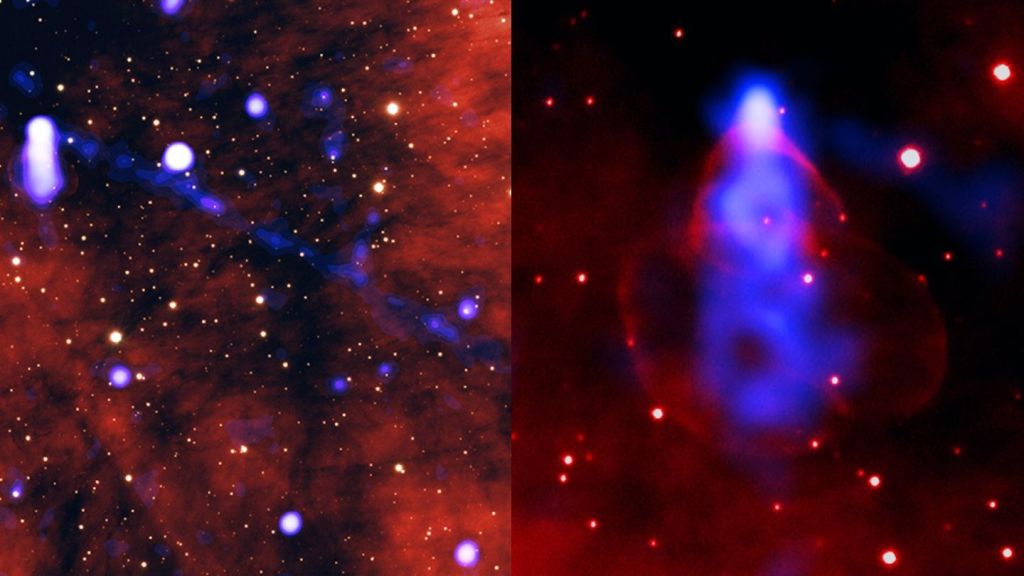Astronomers have discovered an enormous beam made of matter and antimatter that extends for 40 trillion miles across interstellar space, making it the largest apparent structure of its kind ever spotted, reports a new study.
The record-breaking jet is shooting out of a pulsar, a type of rapidly spinning dead star, located some 1,600 light-years from Earth. Pulsars have incredibly strong magnetic fields and this particular object, known as PSR J2030+4415 (or J2030 for short), is spinning at a mind-boggling clip of three times per second.
Videos by VICE
This rapid rotation and intense magnetic strength create natural particle accelerators around pulsars that can forge matter and its opposite counterpart, antimatter, out of pure energy. Observing such extreme environments in our galaxy, the Milky Way, can shed light on unresolved questions about our cosmic surroundings, such as the source of antimatter particles, known as positrons, that end up at Earth.
Stanford University astrophysicists Martijn De Vries and Roger Romani first spotted the beam at J2030 in 2020 with NASA’s Chandra X-ray Observatory, but it was so large that it extended “dramatically further than in the discovery image,” according to a preprint of the team’s new study, which has been accepted for publication in The Astrophysical Journal.
The team has since captured follow-up observations with Chandra that reveal this jet, known as an X-ray filament, is at least triple the size of the first detection. As a result of its enormous scale and relative proximity to Earth, the filament stretches across a space equivalent to half the face of the Full Moon, making it the longest structure of its kind in apparent size in the sky, though there is a longer filament in absolute size located eight times further from Earth, a distance that makes it appear smaller in the sky.
“There are so few of these [filaments] known (it is a quite recently recognized phenomenon) so finding it was quite exciting,” said Romani in an email, recalling the initial detection in 2020. “My post doc Martijn was looking at the data and noticed a funny line across the X-ray image, starting from the pulsar. He asked if it could be an instrumental artifact, but luckily I had looked into pulsar filaments before and recognized it as such.”
“It was still quite thin as it ran off the edge of the Chandra field of view so we knew it would go further, but not how far,” he continued. “The new data show that it pretty much covers the new field as well—it is starting to spread out but may extend a bit further. This is interesting as it indicates the particles are flowing relatively freely along the filament, at a fair fraction of the speed of light. They have to go fast to get that far before the pulsar moves on.”
Pulsars are born from the explosive deaths of stars and they contain at least the mass of our Sun inside a tiny roiling sphere of hyper-dense matter that measures only about 10 miles wide. While thousands of pulsars have been discovered, only a handful have been observed shooting out these gargantuan filaments, which shine brightly in X-ray light.
“It’s amazing that a pulsar that’s only 10 miles across can create a structure so big that we can see it from thousands of light-years away,” said de Vries, who led the new study, in a statement. “With the same relative size, if the filament stretched from New York to Los Angeles the pulsar would be about 100 times smaller than the tiniest object visible to the naked eye.”
In their new study, de Vries and Romani suggest that these rare X-ray filaments form when a pulsar’s strong magnetic field is not able to contain the tempestuous winds produced by these extreme objects. As pulsars hurtle through space, they are shielded by a forward bow shock that normally prevents these winds, which carry charged particles, from spilling out into interstellar space.
However, the winds seem to have sprung a leak in the bow shock at J2030 within the past few decades, producing a “breakthrough event” that produced this brilliant beam of X-ray light, according to the study. The filament is filled with electrons and positrons, which are antimatter versions of electrons that carry a positive charge.
Antimatter particles are vastly outnumbered in the universe compared to the atomic components that we are familiar with, such as electrons, neutrons, and protons. Yet despite these asymmetric concentrations, positrons are frequently captured in detectors on Earth, presenting a puzzle for scientists about their origin. The recent observations of these pulsar filaments might explain where some of these positrons come from because they “provide a channel for pulsar antimatter positrons to escape and spread through the galaxy and thus may contribute to the positron excess here at Earth,” Romani said.
The truly pyrotechnic dynamics of these filaments and their implications for understanding antimatter in the Milky Way makes them a compelling target for further observations. These future studies will have “important implications for the propagation of pulsar cosmic ray positrons through the nearby [interstellar medium] to Earth detectors,” noted the team in the study.
“With only four known, finding more is a priority,” Romani concluded. “We realized that most past Chandra observations target pulsars that should not have filaments. We have proposed to look at a set that are much more likely to host them. We hope the observations are made and we find a few more.”




